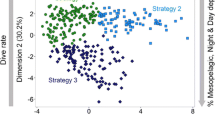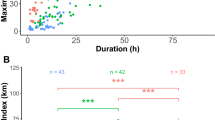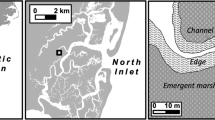Abstract
Studies have shown that pelagic predators do not overlap with their prey at small scales. However, we hypothesized that spinner dolphin foraging would be affected by the spatio-temporal dynamics of their prey at both small and large scales. A modified echosounder was used to simultaneously measure the abundance of dolphins and their prey as a function of space and time off three Hawaiian islands. Spinner dolphin abundance closely matched the abundance patterns in the boundary community both horizontally and vertically. As hypothesized, spinner dolphins followed the diel horizontal migration of their prey, rather than feeding offshore the entire night. Spinner dolphins also followed the vertical migrations of their prey and exploited the vertical areas within the boundary layer that had the highest prey density. Cooperative foraging by pairs of dolphins within large groups was evident. The geometric and density characteristics of prey patches containing dolphins indicate that dolphins may alter the characteristics of prey patches through this cooperative foraging. The overlap of Hawaiian spinner dolphins and their prey at many temporal and spatial scales, ranging from several minutes to an entire night and 20 m to several kilometers, indicates that the availability of truly synoptic data may fundamentally alter our conclusions about pelagic predator-prey interactions.





Similar content being viewed by others
References
Anderson JGT (1991) Foraging behavior of the American white pelican (Pelecanus erythrorhyncos) in western Nevada. Colon Waterbirds 14:166–172
Au WWL (1996) Acoustic reflectivity of a dolphin. J Acoust Soc Am 99:3844–3848
Benoit-Bird KJ, Au WWL (2001) Target strength measurements of animals from the Hawaiian mesopelagic boundary community. J Acoust Soc Am 110:812–819
Benoit-Bird KJ, Au WWL, Brainard RE, Lammers MO (2001) Diel horizontal migration of the Hawaiian mesopelagic boundary community observed acoustically. Mar Ecol Prog Ser 217:1–14
Blaxter JHS (1974) The role of light in the vertical migration of fish—a review. In: Evans GC, Bainbridge R, Rackham O (eds) Light as an ecological factor: II The 16th symposium of the British Ecological Society. Blackwell, Oxford
Boyd II (1996) Temporal scales of foraging in a marine predator. Ecology 77:426–434
Clarke GW (1970) Light conditions in the sea in relation to the diurnal vertical migrations of animals. In: Farquar GB (ed) Proceedings of an international symposium on biological sound scattering in the ocean. Department of the Navy, Washington, pp 41–50
Clarke T (1978) Diel feeding patterns of 16 species of mesopelagic fishes from Hawaiian waters. Fish Bull 76:495–513
Croll DA, Tershy BR, Hewitt RP, Demer DA, Fiedler PC, Smith SE, Armstrong W, Popp JM, Kiekhefer T, Lopez VR et al (1998) An integrated approach to the foraging ecology of marine birds and mammals. Deep-Sea Res II 45:1353–1371
Enright JT (1977) Diurnal vertical migration: adaptive significance and timing. Limnol Oceanogr 22:856–886
Fauchald P, Erikstad KE, Skarsfjord H (2000) Scale dependent predator-prey interactions: the hierarchical spatial distribution of seabirds and prey. Ecology 81:773–783
Gilmartin M, Revelante N (1974) The 'island mass' effect on the phytoplankton and primary production of the Hawaiian Islands. J Exp Mar Biol Ecol 16:181–204
Goss C, Bone DG, Peck JM, Everson I, Murray GLJ, Huntand AWA (1997) Small-scale interactions between prions Pachyptila spp. and their zooplankton prey at an inshore site near Bird Island, South Georgia. Mar Ecol Prog Ser 154:41–51
Greco NM, Liljesthrom GG, Sanchez NE (1999) Spatial distribution and coincidence of Neoseiulus californicus and Tetranychus urticae (Acari: Phytoseiidae, Tetranychidae) on strawberry. Exp Appl Acarol 23:567–580
Greene CH, Wiebe PH, Zamon JE (1994) Acoustic visualization of patch dynamics in oceanic ecosystems. Oceanography 7:4–12
Ives AR, Kareiva P, Perry R (1993) Response of a predator to variation in prey density at three hierarchical scales: Lady beetles feeding on aphids. Ecology 74:1929–1938
Johnson CS (1967) Sound detection thresholds in marine mammals. In: Tavolga W (ed) Marine BioAcoustics. Pergamon Press, New York, pp 247–260
Legendre P, Legendre L (1998) Numerical Ecology, vol 20, 2nd English edn. Elsevier, New York
Logerwell EA, Hargreaves B (1996) The distribution of sea birds relative to their fish prey off Vancouver Island: opposing results as large and small spatial scales. Fish Oceanogr 5:163–175
Love RH (1970) Dorsal-aspect target strength of an individual fish. J Acoust Soc Am 49:816–823
MacLennan DN, Simmonds EJ (1992) Fisheries Acoustics. Chapman and Hall, New York
Mason DM, Brandt SB (1996) Effects of spatial scale and foraging efficiency on the predictions made by spatially-explicit models of fish growth rate potential. Environ Biol Fishes 45:283–298
Mehlum F, Hunt GLJ, Klusek Z, Decker MB (1999) Scale-dependent correlations between the abundance of Brunnich's guillemots and their prey. J Anim Ecol 68:60–72
Morgan RA, Brown JS, Thorson JM (1997) The effect of spatial scale on the functional response of fox squirrels. Ecol 78:1087–1097
Muotka T, Penttinen A (1994) Detecting small-scale spatial patterns in lotic predator-prey relationships: statistical methods and a case study. Can J Fish Aquat Sci 51:2210–2218
Norris KS, Dohl TP (1980) Behavior of the Hawaiian spinner dolphin, Stenella longirostris. Fish Bull 77:821–849
Norris KS, Würsig B, Wells RS, Würsig M (1994) The Hawaiian Spinner Dolphin. University of California Press, Berkeley
Pearre S (1979) Problems of detection and interpretation of vertical migration. J Plankton Res 1:29–44
Piontkovski SA, Williams R (1995) Multiscale variability of tropical ocean zooplankton biomass. ICES J Mar Sci 52:643–656
Reid SB (1994) Spatial structure of the mesopelagic fish community in the Hawaiian boundary region. PhD Dissertation Department of Oceanography, University of Hawaii, Honolulu
Ringelberg J (1995) Changes in light intensity and diel vertical migration: a comparison of marine and freshwater environments. J Mar Biol Assoc UK 75:15–25
Roe HSJ, Badcock J (1984) The diel migrations and distributions within a mesopelagic community in the north east Atlantic. 5. Vertical migrations and feeding of fish. Prog Oceanogr 13:389–424
Rose GA, Leggett WC (1990) The importance of scale to predator-prey spatial correlations: an example of Atlantic fishes. Ecology 71:33–43
Russell RW, Hunt GL, Coyle KO, Cooney RT (1992) Foraging in a fractal environment: spatial patterns in a marine predator-prey system. Landscape Ecol 7:195–209
Schmitt RJ, Strand SW (1982) Cooperative foraging by yellowtail, Seriola lalandei (Carangidae), on two species of fish prey. Copeia 3:714–717
Serfass TL (1995) Cooperative foraging by North American river otters, Lutra canadensis. Can Field Nat, pp 458–459
Similä T (1997) Sonar observations of killer whales (Orcinus orca) feeding on herring schools. Aquat Mamm 23:119–126
Steele JH (1978) Spatial pattern in plankton communities. Plenum Press, New York
Stewart BD, Jones GP (2001) Associations between the abundance of piscivorous fishes and their prey on coral reefs: Implications for prey-fish mortality. Mar Biol 138:383–397
Tiselius P, Jonsson PR, Verity PG (1993) A model evaluation of the impact of food patchiness on foraging strategy and predation risk in zooplankton. Bull Mar Sci 53:247–264
Webster R (1973) Automatic soil-boundary location from transect data. Math Geol 5:27–37
Würsig B (1986) Delphinid foraging strategies. In: Schusterman RJ (ed) Dolphin cognition and behavior: a comparative approach. Lawrence Erlbaum, Hillsdale, New Jersey, pp 347–359
Zhang ZQ, Sanderson JP (1993) Spatial scale of aggregation in three acarine predator species with different degrees of polyphagy. Oecologia 96:24–31
Author information
Authors and Affiliations
Corresponding author
Additional information
Communicated by F. Trillmich
Rights and permissions
About this article
Cite this article
Benoit-Bird, K.J., Au, W.W.L. Prey dynamics affect foraging by a pelagic predator (Stenella longirostris) over a range of spatial and temporal scales. Behav Ecol Sociobiol 53, 364–373 (2003). https://doi.org/10.1007/s00265-003-0585-4
Received:
Accepted:
Published:
Issue Date:
DOI: https://doi.org/10.1007/s00265-003-0585-4




